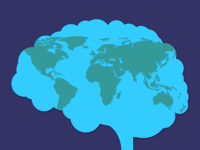Making Connections: Culturally Responsive Teaching and the Brain
Zaretta Hammond's new book, Culturally Responsive Teaching and The Brain: Promoting Authentic Engagement and Rigor Among Culturally and Linguistically Diverse Students, fills a huge gap in my bookshelf. Hoping to get it into your hands and onto your shelves, I decided to do a Q & A with the author.
Edutopia: For those who may not be familiar with this term, "culturally responsive," could you start by defining it?
Zaretta Hammond: As part of my research when writing the book, I would ask teachers what they thought the term meant, and more often than not, they'd say it's a way to get disengaged students of color motivated in the classroom by tying the lesson to Africa, Mexico, or by using hip-hop music.
In reality, cultural responsiveness is more of a process than a strategy. It begins when a teacher recognizes the cultural capital and tools students of color bring to the classroom. She is then able to respond to students' use of these cultural learning tools positively by noticing, naming, and affirming when students use them in the service of learning. The most common cultural tools for processing information utilize the brain's memory systems -- music, repetition, metaphor, recitation, physical manipulation of content, and ritual. The teacher is "responsive" when she is able to mirror these ways of learning in her instruction, using similar strategies to scaffold learning.
For example, a science teacher I mention in the book wasn't having much success with her sixth-grade students learning the science vocabulary. Rather than continue assigning a word list and have kids look words up in the dictionary, we looked at how she could redesign word study using some combination of the cultural tools familiar to her students.
Afterwards, learning weekly vocabulary was more active and game-like. She reported that students were not only re-engaged, but made noticeable progress in using their knowledge of science vocabulary during the lessons.
You'll notice that there's no mention of Africa, Mexico, or race at all. It's a misconception that culturally responsive instruction has to mention race. It's not race that matters in culturally responsive teaching but awareness of implicit bias that gets in the way of healthy student-teacher relationships and narrow interpretations of learning that ignore the cultural tools students bring to class.
Who is the primary audience for your book? Who do you hope will read it?
This is the first year that our public schools have a majority minority student population. That means our classrooms are more racially, linguistically, and culturally diverse than they have ever been, but the majority of our teaching force is still white.
Historically, students of color experience cross-cultural equity issues that contribute to the achievement gap. Closing this gap is where teachers need support. I believe the book will be a resource for instructional coaches as they build their own knowledge and skill around how to help teachers increase their cultural responsiveness.
I hope every teacher gets a copy of the book and reads it with other colleagues. Hopefully it will spark classroom inquiry in identifying what cultural capital students are bringing to school and how to mirror them during instruction.
What are three things that you hope readers will take away from your book?
First I want teachers to get that you don't have to learn 19 different cultures to be effective. Teachers need to simply begin with understanding the cultural dimensions of communalism -- most communities of color have this cultural trait in common, namely a focus on the interdependence of the group. It can be summed up in the African proverb, "I am because we are." This way of being is contrasted with our dominant culture's more individualist, pull-yourself-up-by-your-bootstraps worldview.
The second thing is how important it is to build trusting relationships with students who feel marginalized or misunderstood. The neuroscience is clear on the connection between emotions, trust, and learning. Stress hormones from mistrust block cognition. Students respond to a teacher's focus on care by giving her permission to be tough and push them toward higher achievement.
And last, I hope they take from the book new processes and strategies for operationalizing culturally responsive teaching. I see a lot of school districts using the term, but there isn't much guidance to help teachers build the routines, processes, and structures in their classrooms so that it becomes more than a gimmick.
I'm most intrigued by the title of chapter three, "This Is Your Brain on Culture." Can you give a quick synopsis of that chapter?
This is where the neuroscience is so cool in helping us understand the role of culture in learning. It is like software that programs our "hardware" (the brain). Cultural values and learning practices transmitted from our parents and community guide how the brain wires itself to process information and handle relationships. Neural pathways are over-developed around one's cultural ways of learning.
Culturally responsive teachers know this and piggyback on these well-developed neural pathways with similar types of instruction. Tapping into these neural pathways can help students accelerate their own learning.
I have a huge stack of education-related books that I want to read. Can you convince me why I should read your book?
There are so many good books out there we should be reading that provide new strategies and best practices. But this book isn't a collection of so called "best practices" for African American students or English learners. Instead it provides a framework that helps teachers learn about the resources any group of students brings to class.
The added bonus is that sharing the neuroscience behind culturally responsive moves can help teachers really get it.
